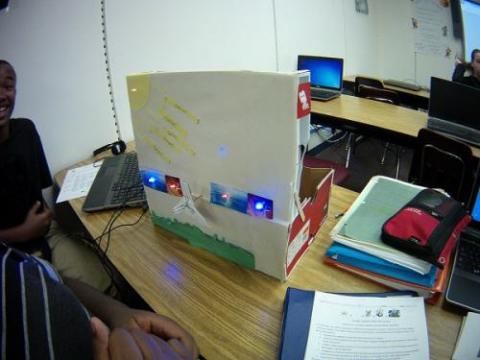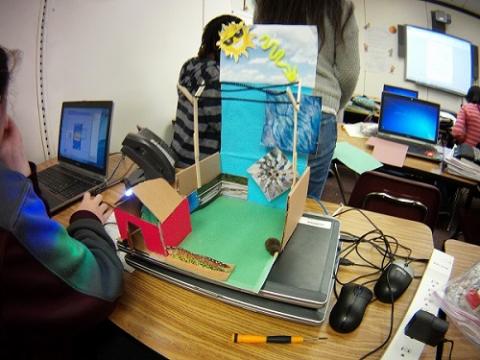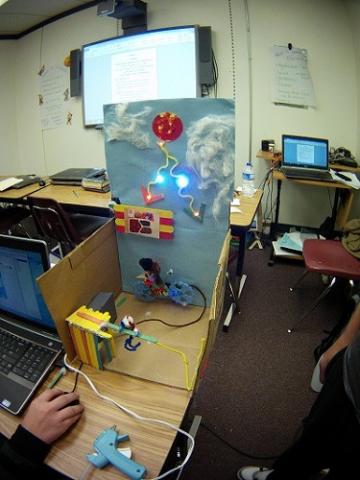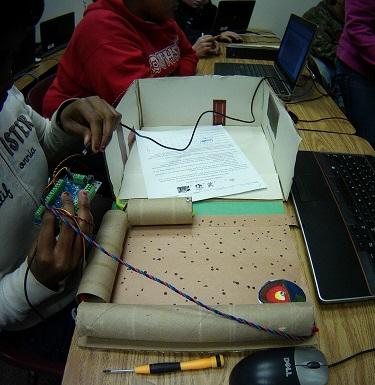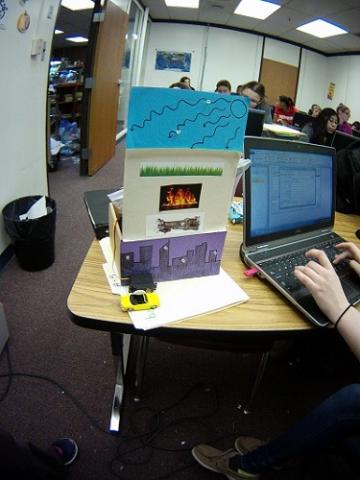Energy Transformations Using Hummingbird Robotics
Subjects
Science
Project Type
Engineering & Inventions
Required Tutorials
Position servo, Rotation servo, Single color LED, Tri-color LED, & Sensors
Estimated Time
Long (6+ hours)
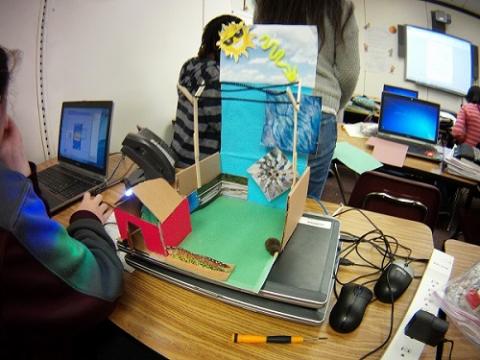
Description
This is a problem-based learning project focusing on energy conversions and the engineering process.
Free Teacher Materials
Project Map
Learning Goals
- The student will show an understanding of the transformation of energy as it moves through our world.
- The student will create a representation of the energy conversions happening in the scenario they are given using the Hummingbird Robotics kit.
- The student will create a report analyzing the energy conversion method given to their group and their recommendation on whether or not it is a cost-effective option for creating electricity in Nottoway County.
- The student will participate in an oral presentation of their robot, including a brief summary of the written report, a demonstration of the energy transformation robot, and an oral discussion of the problems they encountered during the build and their solutions.
- The student will develop the skills of collaboration, cooperation, and problem-solving while learning more about a way to generate electricity and the energy conversions required to produce electricity.
Materials
- Hummingbird Bit Premium Kit
- Scissors
- Glue gun/sticks
- Tape- scotch, electrical, masking, duct
- Pipe cleaners
- Cardboard
- Popsicle sticks
- Wire
- String
- Possible Craft supplies
Tips
- Have students work in groups of 2-3.
- Our Printables page has a variety of documents for making teaching and learning with Hummingbird easier. Visit and explore resources like the My First Robot Design Notebook now.
Steps
Lesson 1: Introduction to Hummingbird Robotics kit/Create visual programmer basics
- Hummingbird Powerpoint from Tom Lauwers and hands-on instruction on the basic steps of using Hummingbird robotics kit. Students were asked to:
- install 3 LEDs
- make those lights flash in succession
- install a tri-color LED
- make it flash 3 different colors
- install a servo & sensor
Lesson 2: Project problem introduction (see problem explanation above)
- Go over rubrics
- Oral presentation http://rubistar.4teachers.org/index.php?screen=ShowRubric&rubric_id=2492526&
- Robot itself http://rubistar.4teachers.org/index.php?screen=ShowRubric&rubric_id=2492525&
- Written report http://rubistar.4teachers.org/index.php?screen=ShowRubric&rubric_id=2492527&
- Choose a method of generating electricity the group would like to research. Ask students what methods they can remember from class instruction. Put up a poster with a list after discussion:
- Ways to generate electricity:
- Hydropower (dam)
- Wind
- Solar
- Geothermal
- Nuclear
- Burning fossil fuels (coal, oil, natural gas)
- Biomass
- Pedaling bicycles
- Ways to generate electricity:
- Students are asked to create a PowerPoint with images/captions, a vlog, a blog, a journal… something to log their process from plan through stages of testing and modification to the final product, and this will be the focus of the oral presentation.
- Begin research and planning
Lessons 3-5: Research and planning in the library
- Research requirements include using 2 media types and citing 3 distinct sources properly. Library has provided most recent published texts on energy types, purchased specifically to support this unit/curriculum. Instruction on online research, including website integrity delivered before research commencement. Students are encouraged to search for the following information:
- Invention/discovery of…
- Development of…
- Historical applications of…
- Environmental impact of…
- Jobs created by…
- Will new buildings need to be built? Cost?
- Cost efficiency of…
- *DON’T FORGET* -citations –charts –diagrams –graphs –tables
- Designing and creating a schematic of robots. Meet with the builder and planner to discuss the basic requirements of the robot (has to fit on the table, does NOT have to have “arms & legs & head”, needs to CLEARLY represent the energy transformations happening for their form of electricity creation; may use images from online (with citations) or draw/create out of craft materials
Lessons 6-9: Building of Robots, Troubleshooting, writing of reports in the library
- Checking to make sure students are journaling their troubleshooting as the robot works through stages of development
- Checking for minimum components
- Ironing out bugs
- Finalizing & printing written reports
- Rehearsing for presentations
Lesson 10: Oral presentations of robots in the library
- All students must participate
- Allowed one extra day in the library just in case!
Standards Alignment
This project is aligned with Next Generation Science Standard MS-ESS2-1: “Develop a model to describe the cycling of Earth’s materials and the flow of energy that drives this process,” as well as NGSS standards in engineering design (MS-ETS1-1 – MS-ETS1-3). It could be modified to address other standards related to energy transfer, such as MS-LS2-3. This project is also aligned with Common Core ELA anchor standards that focus on informative writing (CCSS.ELA-LITERACY.CCRA.W.2), research (CCSS.ELA-LITERACY.CCRA.W.7-8), and speaking and listening (CCSS.ELA-LITERACY.CCRA.SL.4-6).

